Why Vanilla Protein Powder Is Everywhere (And Why You Should Care)
You’ve probably seen it in smoothies, shaker bottles at the gym, and even baked into pancakes. Vanilla protein powder is having a moment. And it’s not just for bodybuilders anymore. Whether you’re a busy parent trying to stay full until lunch, a college student on a budget, or someone working toward a fitness goal, this stuff is pure gold.
But with so many options on the shelves, things can get confusing fast. Is whey better than plant-based? What sweeteners are safe? Should you go for the one with the pretty label or the one with 25 grams of protein?
This guide breaks it all down for you, no fluff, just what works, what to avoid, and how to get the most out of your scoop.
By the end of this article, you’ll be confident in picking the right vanilla protein powder for your needs, and you’ll have some creative ideas to use it too.
What Is Vanilla Protein Powder?
At its core, vanilla protein powder is a powdered nutritional supplement made by isolating protein from a food source, usually milk, peas, or other plants, and flavoring it with vanilla.
Think of it like concentrated protein. The kind you can mix into water, almond milk, yogurt, or even your pancake batter. It’s designed to help you meet your daily protein needs in a way that’s:
- Fast
- Convenient
- Easy to digest
- Surprisingly tasty (when you pick the right one)
Let’s break that down a bit more.
Table of Contents
Table of Contents
Common Types of Vanilla Protein Powders
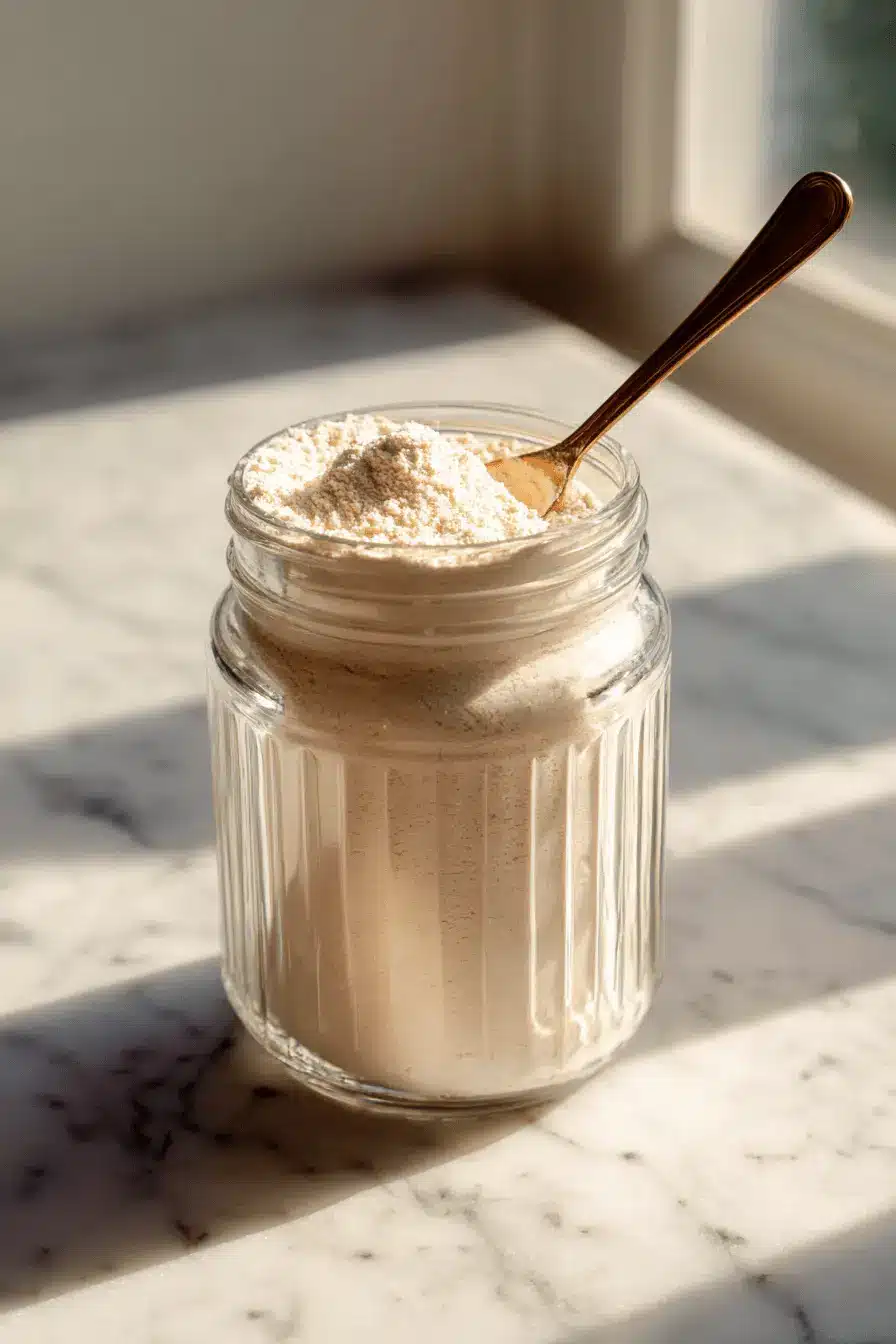
1. Whey-Based Vanilla Protein Powders
This is the classic option, made from milk. You’ll see terms like:
- Whey concentrate – Cheaper, slightly more carbs and fats
- Whey isolate – More pure protein, faster digestion, lower lactose
- Whey hydrolysate – Pre-digested for super-fast absorption
Whey is popular because it’s a complete protein, meaning it contains all nine essential amino acids. It also mixes well and tends to have a creamy, milkshake-like texture.
2. Plant-Based Vanilla Protein Powders
These are ideal if you’re vegan, lactose intolerant, or prefer a dairy-free option. They use proteins from sources like:
- Pea
- Brown rice
- Hemp
- Pumpkin seed
- Quinoa
Many brands blend several plant proteins to improve the amino acid profile. The taste and texture have improved dramatically in recent years, especially in premium brands.
3. Collagen and Other Alternatives
Although not complete proteins, collagen protein powders are also available in vanilla flavor. They’re better for skin, joints, and connective tissues, but not ideal for muscle building alone.
Recommended Product:
Try this Vanilla Protein Powder highly rated, affordable, and perfect for smoothies or baking.
What Goes Into a Vanilla Protein Powder?
Here’s what you’ll usually find on the label:
- Protein source (whey, pea, rice, etc.)
- Flavoring – Natural vanilla, vanilla bean extract
- Sweetener – Stevia, monk fruit, sucralose, or sugar alcohols
- Thickeners – Xanthan gum, guar gum
- Optional extras – Digestive enzymes, probiotics, MCT oil, fiber
Not all powders are created equal. Some are loaded with artificial junk or taste like sweetened chalk. That’s why knowing how to read the label (which we’ll get into next) matters so much.
Benefits of Vanilla Protein Powder
Adding vanilla protein powder to your daily routine might sound like a fitness influencer move, but the benefits go far beyond muscle growth. Whether you’re trying to tone up, slim down, or just get through your afternoon without crashing, a scoop of this stuff can be a total game-changer.
Let’s break down the top benefits and why it’s worth making room for in your pantry.
1. Muscle Building and Recovery
This is the obvious one, but let’s unpack it.
Protein is made up of amino acids, which are the building blocks your body uses to repair and grow muscle tissue. After a workout, especially one that includes strength training, your muscles develop tiny tears. The right amount of protein helps rebuild them stronger.
Vanilla protein powders, especially those made with whey isolate or a complete plant-based blend, provide a quick and easy way to get those amino acids into your system when it counts most: right after a workout.
Bonus tip: Combine your vanilla protein with carbs (like a banana or oats) post-workout to maximize recovery and glycogen replenishment.
2. Weight Management and Satiety
One of the best (and often overlooked) perks of protein? It helps you stay full longer.
Here’s what happens: protein slows down digestion, curbs cravings, and reduces those “I need a snack now” moments. That’s why a vanilla protein shake in the morning or afternoon can keep you from reaching for the cookie jar.
Studies show that high-protein diets can support fat loss, especially when paired with strength training.
✅ Pro Tip: Make a high-protein vanilla smoothie using almond milk, chia seeds, and frozen berries. It tastes like dessert but keeps you satisfied for hours.
Need more ideas? Our Protein Cookies recipe is a perfect make-ahead breakfast that feels like a treat.
3. Digestive Health and Clean Formulas
If you’ve ever felt bloated or gassy after a protein shake, you’re not alone. That’s often due to:
- Low-quality ingredients
- Artificial sweeteners
- Lack of digestive support
The good news? Many newer vanilla protein powders are designed to be gut-friendly, using:
- Natural sweeteners like monk fruit or stevia
- Added digestive enzymes (like protease or papain)
- Dairy-free or lactose-free formulas
- No gums or fillers
Choosing a clean, simple formula helps reduce digestive discomfort and makes it easier to incorporate protein powder into your daily life, with no bloating, no regrets.
4. Convenience Without the Compromise
Life gets busy. Maybe you skip meals. Maybe you grab junk food because it’s fast. This is where vanilla protein powder shines.
You can:
- Shake it with water or milk for a 30-second snack
- Add it to a smoothie and call it breakfast
- Mix it into oatmeal, pancakes, or muffins
It’s fast food, but make it nutritional.
5. Balanced Blood Sugar and Energy Levels
Protein slows the absorption of sugar into your bloodstream. That means adding protein powder to your breakfast or snack can help prevent:
- Mid-morning energy crashes
- Afternoon brain fog
- Overeating at dinner
Pairing vanilla protein with fiber-rich carbs and healthy fats creates a balanced meal that supports stable energy throughout the day.
6. Supports Healthy Hair, Skin, and Nails
If you’re using a collagen-based vanilla protein, or a mix that includes biotin or hyaluronic acid, you may also see improvements in:
- Skin elasticity
- Nail strength
- Hair growth and thickness
Even standard whey and plant protein help, since amino acids are essential to these systems.
💡 Want more nutrition tips? Don’t miss our guide on Blueberry Banana Oatmeal Pancakes
Quick Recap: What Vanilla Protein Powder Can Do for You
| Benefit | Why It Matters |
|---|---|
| Muscle Repair | Faster recovery after workouts |
| Appetite Control | Keeps you fuller, longer |
| Weight Loss Support | Helps burn fat, preserve lean muscle |
| Convenience | Ready in seconds, fits any schedule |
| Gut-Friendly Options | No bloating or discomfort |
| Energy Support | More stable blood sugar = fewer crashes |
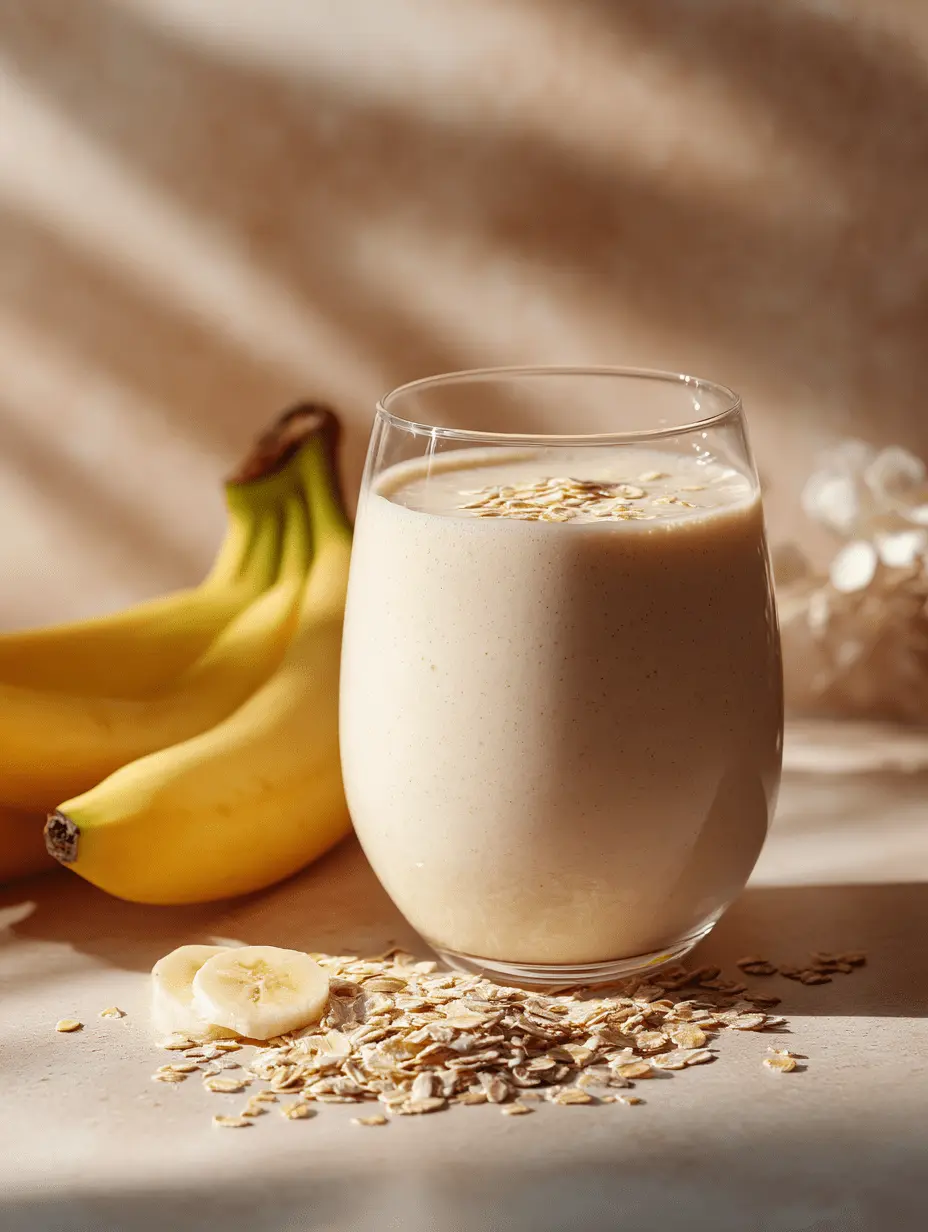
How to Choose the Best Vanilla Protein Powder
With hundreds of options on the market, picking the right vanilla protein powder can feel like decoding a secret language. Every label screams things like “clean,” “grass-fed,” “zero sugar,” or “plant-powered,” but what matters?
Here’s your simple, no-BS guide to picking a powder that works for your body, your taste buds, and your budget.
1. Ingredient Transparency
Always, and we mean always, check the ingredient list. A clean, honest vanilla protein powder should be:
- Short and simple: You don’t want a novel of unpronounceable additives.
- Free from artificial sweeteners like aspartame or acesulfame potassium (unless you’ve verified their safety and prefer the taste).
- Naturally flavored: Look for real vanilla bean, not “vanillin” or vague “flavors.”
What to watch out for:
- Hidden sugars (like maltodextrin or corn syrup solids)
- Fillers (maltodextrin, soy lecithin, gums)
- Cheap protein blends (like collagen filler in a whey product)
Bonus tip: If a brand doesn’t clearly label how much protein per scoop you’re getting, move on.
2. Protein Source and Quality
The type of protein matters both for your goals and your digestion.
If you want fast absorption (post-workout):
- Choose whey isolate, it’s fast-digesting, high in leucine, and nearly lactose-free.
If you want steady, plant-based protein:
- Look for blends of pea, rice, and chia/hemp. These mimic the full amino acid profile of animal protein.
If you have allergies:
- Skip dairy-based options. Use sunflower protein, pumpkin seed, or rice protein instead.
Here’s a quick comparison table:
| Type | Best For | Notes |
|---|---|---|
| Whey Isolate | Muscle building, quick recovery | Low lactose, fast digestion |
| Plant-Based Blends | Vegan, food sensitivities | Slower release, gentle on gut |
| Collagen | Hair, skin, joints | Not a complete protein |
3. Flavor and Mixability
This is where many protein powders crash and burn.
Ask yourself:
- Does it mix well in just water or milk?
- Is it chalky or gritty?
- Does it leave an aftertaste?
Look for products that:
- Use real vanilla extract or vanilla bean powder
- Avoid artificial thickeners (these cause clumps)
- They are reviewed well for texture and taste
✅ Pro Tip: Read Amazon reviews or Reddit threads for real user feedback. If people say “it’s like drinking cake batter,” that’s a green flag.
If you want to test a protein for baking or smoothies, we recommend our Vanilla Banana Protein Bread. It’s fluffy, easy, and perfect for picky eaters.
4. Budget-Friendly vs. Premium Options
Let’s be honest, some powders cost a fortune just for the fancy tub.
Here’s what to consider:
| Budget | What You Get |
|---|---|
| Under $30 | Often concentrate blends, bigger tubs, less pure |
| $30–$50 | Quality whey isolate or multi-source plant proteins |
| $50+ | Organic, third-party tested, added extras like probiotics, enzymes |
Don’t pay more for hype. Pay for verified quality, transparent sourcing, and no junk fillers.
5. Bonus Features to Look For
If you want extra value, some brands include:
- Digestive enzymes (for easier digestion)
- MCT oil or fiber (for energy or fullness)
- Probiotics (for gut health)
- Third-party testing badges (like NSF or Informed-Sport)
These aren’t must-haves, but they can help justify a slightly higher price if you need those perks.
Final Tip: Try Before You Commit
Many brands offer sample packs or travel-size sachets. This is a great way to test:
- Taste
- Digestibility
- Mixability
Before dropping $50 on a tub, try 1–2 servings if you can.
Recommended Product:
Try this Vanilla Protein Powder highly rated, affordable, and perfect for smoothies or baking.
Homemade Vanilla Protein Powder (DIY Clean Blend)
Why Make It at Home?
- No artificial sweeteners or flavors
- Customizable based on your dietary needs (vegan, dairy-free, paleo)
- Cost-saving over time
- No additives or fillers
Ingredients (Base Recipe: ~10 servings)
Protein Sources (choose one or mix)
- 1 cup dry milk powder (for whey-like profile)
or - 1 cup pea protein powder (for vegan version)
or - 1 cup hemp seed powder *(great amino acid profile)
Texture & Creaminess
- 1/4 cup powdered oats (use rolled oats blended into a fine flour)
- 1/4 cup ground flaxseed or chia seeds
Vanilla Flavor & Sweetness
- 2 tsp real vanilla bean powder or scraped vanilla pod
or use 1 tbsp pure vanilla extract powder (not liquid) - 2 tbsp coconut sugar or 1 tbsp monk fruit powder
(adjust to taste, optional)
Add-ins (optional, but powerful)
- 1 tbsp psyllium husk powder for fiber
- 1 tsp cinnamon for flavor and blood sugar balance
- A pinch of Himalayan salt enhances the taste
Instructions
- Grind oats in a blender or spice grinder until finely powdered (if not using oat flour).
- Add all ingredients to a large food processor or dry blender.
- Blend until well combined and powdery.
- Store in an airtight jar at room temperature for up to 1 month.
How to Use
- 1 scoop (about 1/4 cup) = ~20g protein depending on your chosen base
- Mix into smoothies, overnight oats, baked goods, or just blend with milk or water
Pro Tips
- For higher protein content, use egg white powder (non-vegan) or a combo of hemp + pea protein.
- Add collagen peptides (if not vegan) to boost hair/skin/joint support.
- Want it completely sugar-free? Use stevia leaf powder or monk fruit instead of coconut sugar.
Nutrition Estimate (per 1/4 cup scoop)
(Varies by exact ingredient choice)
| Nutrient | Approximate Amount |
|---|---|
| Protein | 18–22g |
| Carbs | 5–8g |
| Fats | 2–4g |
| Fiber | 3–5g |
| Sugar | 1–2g (or 0g if unsweetened) |
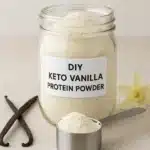
Vanilla Protein Powder: The Ultimate Guide
- Total Time: 5 minutes
- Yield: 10 servings
Description
A clean, customizable homemade vanilla protein powder made with simple pantry ingredients. Great for smoothies, oats, and baking, dairy-free and budget-friendly.
Ingredients
1 cup pea protein or dry milk powder (your choice)
1/4 cup ground oats (or oat flour)
1/4 cup ground flaxseed or chia seeds
2 tsp vanilla bean powder or vanilla extract powder
2 tbsp coconut sugar or 1 tbsp monk fruit powder
1 tbsp psyllium husk powder (optional, for fiber)
1 tsp cinnamon (optional)
Pinch of Himalayan salt
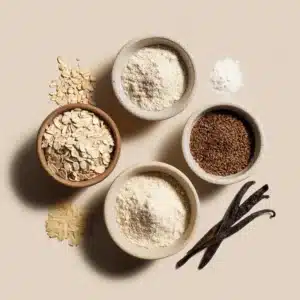
Instructions
1. Grind oats into fine flour if using whole oats.
2. Add all ingredients to a food processor or blender.
3. Blend until the texture is fine and well combined.
4. Transfer to an airtight jar or container.
5. Store at room temperature up to 1 month.
6. Use 1/4 cup (1 scoop) per serving in smoothies or recipes.
Notes
Use different protein bases like hemp seed or egg white if preferred.
Add collagen peptides for skin and joint support (not vegan).
Skip the sweetener entirely for a neutral base.
Try it in pancakes, overnight oats, or protein bars.
- Prep Time: 5 minutes
- Cook Time: 0 minutes
- Category: DIY Protein Powder
- Method: No-Cook
- Cuisine: Health
Creative Ways to Use Vanilla Protein Powder
You’ve got your scoop of vanilla protein powder, now what?
If you’re tired of plain shakes or gritty drinks, you’re in luck. Vanilla is one of the most versatile flavors when it comes to protein. You can use it in sweet and savory dishes, hot or cold, and even baked goods.
Here are creative, delicious, and totally practical ways to make vanilla protein powder a regular part of your day.
1. Power-Packed Smoothies
This is the classic, but with a twist.
Smoothie Ideas:
- Tropical Sunrise: Vanilla protein + frozen mango + pineapple + coconut milk
- Peanut Butter Cup: Vanilla protein + banana + peanut butter + almond milk
- Green Glow: Vanilla protein + spinach + cucumber + green apple + chia + oat milk
2. Overnight Oats
This combo is a meal prep dream. It tastes like dessert but keeps you full for hours.
Basic Formula:
- 1/2 cup rolled oats
- 1 scoop vanilla protein powder
- 1/2 cup almond milk
- 1 tbsp chia seeds
- 1/2 banana (mashed)
Let it sit overnight in a jar. Add berries or peanut butter in the morning.
Try it now with our High-Protein Overnight Oats Recipe. It’s creamy, satisfying, and endlessly customizable.
3. Protein Pancakes or Waffles
Yes, protein can taste like brunch.
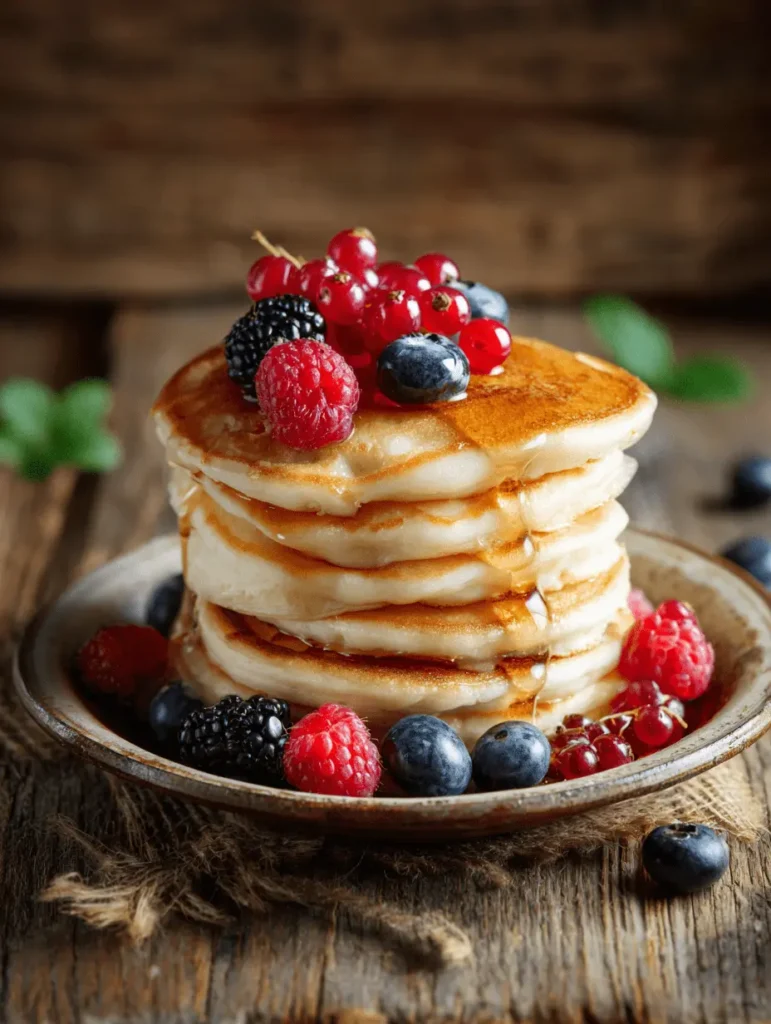
Quick recipe:
- 1 banana (mashed)
- 2 eggs
- 1 scoop vanilla protein powder
- 1/4 tsp baking powder
Mix well and cook like pancakes. Top with berries or sugar-free syrup.
4. Yogurt Bowls or Cottage Cheese Blends
Stir a scoop of vanilla protein into:
- Greek yogurt
- Cottage cheese
- Kefir
Add fruit, nuts, or granola for a quick 30g protein breakfast with staying power.
5. Protein Coffee (aka Proffee)
Blend 1 scoop of vanilla protein powder with your iced coffee or cold brew. It creates a creamy, sweet coffee drink without all the sugar.
How to make it:
- Brew strong coffee and chill it
- Shake with 1 scoop of vanilla protein + 1/2 cup almond or oat milk
- Add ice and enjoy
Harvard Health on Protein & Energy
6. Protein Ice Cream or Frozen Treats
Blend your protein into:
- Frozen banana chunks
- A splash of almond milk
- A scoop of peanut butter
Then freeze for 30 minutes and scoop like soft-serve.
Optional: Add cacao nibs or sugar-free chocolate chips.
7. Homemade Protein Bars
Mix:
- 1 cup oats
- 1/2 cup nut butter
- 1/2 cup vanilla protein powder
- 2 tbsp honey
- Pinch of salt
Press into a pan and chill. Cut into bars. Now you have no-bake protein snacks for the week.
8. Add to Baked Goods
Vanilla protein is amazing in:
- Muffins
- Banana bread
- Protein donuts
- High-protein cookies
Pro baking tip: Replace 1/4 of the flour in most recipes with protein powder. Add extra moisture (applesauce, yogurt) to keep it from drying out.
Quick Table: 8 Ways to Use Vanilla Protein Powder
| Use | When to Enjoy |
|---|---|
| Smoothies | Breakfast or post-workout |
| Overnight oats | Make-ahead breakfast |
| Pancakes | Weekend brunch |
| Yogurt/cottage cheese | Quick snack |
| Proffee (Protein coffee) | Morning energy boost |
| Ice cream or frozen treats | Healthy dessert |
| Homemade protein bars | On-the-go snack |
| Baked goods | Healthy treats & meal prep |
Final Tip
Vanilla protein powder works because it’s neutral and mixable. Don’t limit yourself to boring shakes; get creative, use it as a recipe base, and make it something you crave.
FAQs About Vanilla Protein Powder
These are the most frequently asked questions people search on Google about vanilla protein powder, answered in a clear, friendly way.
Is vanilla protein powder good for weight loss?
Yes, when used correctly, vanilla protein powder can help with weight loss. Protein keeps you full longer, stabilizes blood sugar, and reduces cravings. Replacing high-carb or sugary snacks with a vanilla protein smoothie can cut calories and support fat loss without starving yourself.
Bonus: Use it in Blueberry Banana Oatmeal Pancakes for a high-protein breakfast twist.
Can I use vanilla protein powder every day?
Most people can safely consume vanilla protein daily as long as it fits within their overall protein needs. It’s just a food supplement. However, always watch your total intake and avoid overdoing it, especially if you’re getting protein from other meals too.
General guideline:
Active adults: ~0.8–1g of protein per pound of body weight
For weight loss: Increase protein slightly to stay full and preserve muscle
Trusted
Is vanilla protein powder safe during pregnancy or breastfeeding?
Yes, if it’s made with clean, natural ingredients and has no harmful additives. Always choose a protein powder that’s:
Free from artificial sweeteners or preservatives
Tested for heavy metals and contaminants
From a trusted, transparent brand
But still consult your doctor before adding any supplement to your routine during pregnancy or while nursing.
What’s the difference between whey isolate and concentrate?
Both come from milk, but they’re processed differently.
Whey concentrate: ~70–80% protein, contains more lactose and fat, cheaper
Whey isolate: ~90%+ protein, lower lactose, leaner, faster absorption
If you’re lactose-intolerant or watching calories, go for whey isolate. For baking or general use, concentrate can work fine and save you money.
For a dairy-free option, try our Cottage Cheese Bagels Recipe paired with a plant-based protein shake.
Can I cook or bake with vanilla protein powder?
Yes, vanilla protein powder is incredibly versatile in recipes like:
Pancakes
Muffins
Protein bars
Oatmeal
Even ice cream!
Just be sure to add extra moisture when baking, since protein can dry out the batter.
Try it in our Easy Chocolate Malt Ice Cream for a high-protein dessert!
Does it expire or go bad?
Yes, vanilla protein powder has a shelf life typically 12–24 months if unopened and stored in a cool, dry place. After opening, try to use it within 6–9 months for the best flavor and freshness.
Always check:
Expiration date on the label
Smell and texture before use
If it smells sour, clumps badly, or tastes off, toss it.
Conclusion: Is Vanilla Protein Powder Worth It?
If you’re trying to eat better, build muscle, recover faster, or just feel more satisfied after meals, vanilla protein powder might be your secret weapon.
Here’s why it deserves a spot in your pantry:
- It’s flexible: great in shakes, oats, pancakes, and even coffee.
- It supports real health goals: fat loss, muscle gain, energy, and digestion.
- You can go clean, budget-friendly, or gourmet depending on your needs.
And whether you’re vegan, keto, lactose-intolerant, or just flavor-obsessed, there’s a version out there that works for you.
Either way, vanilla protein powder isn’t just a supplement; it’s a strategy.

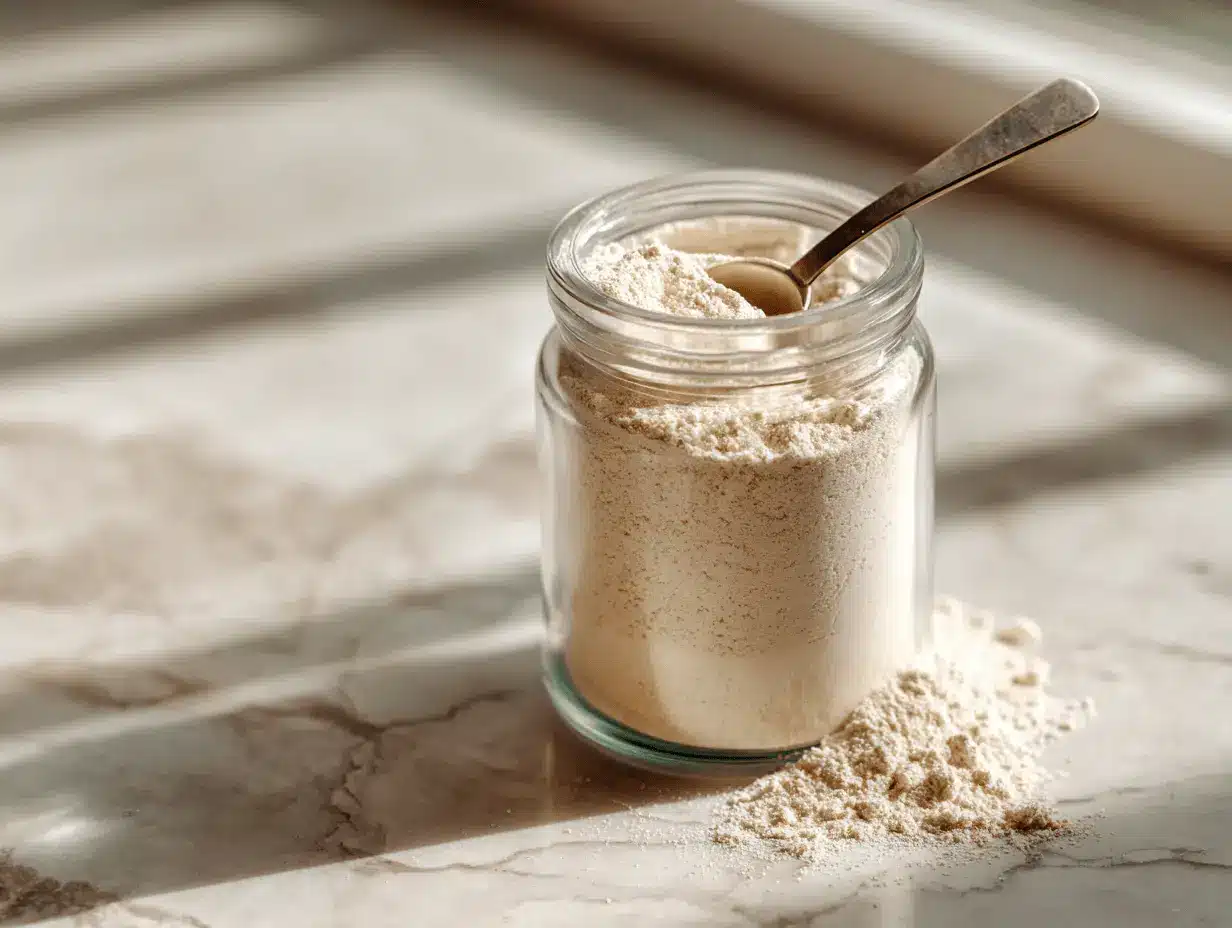
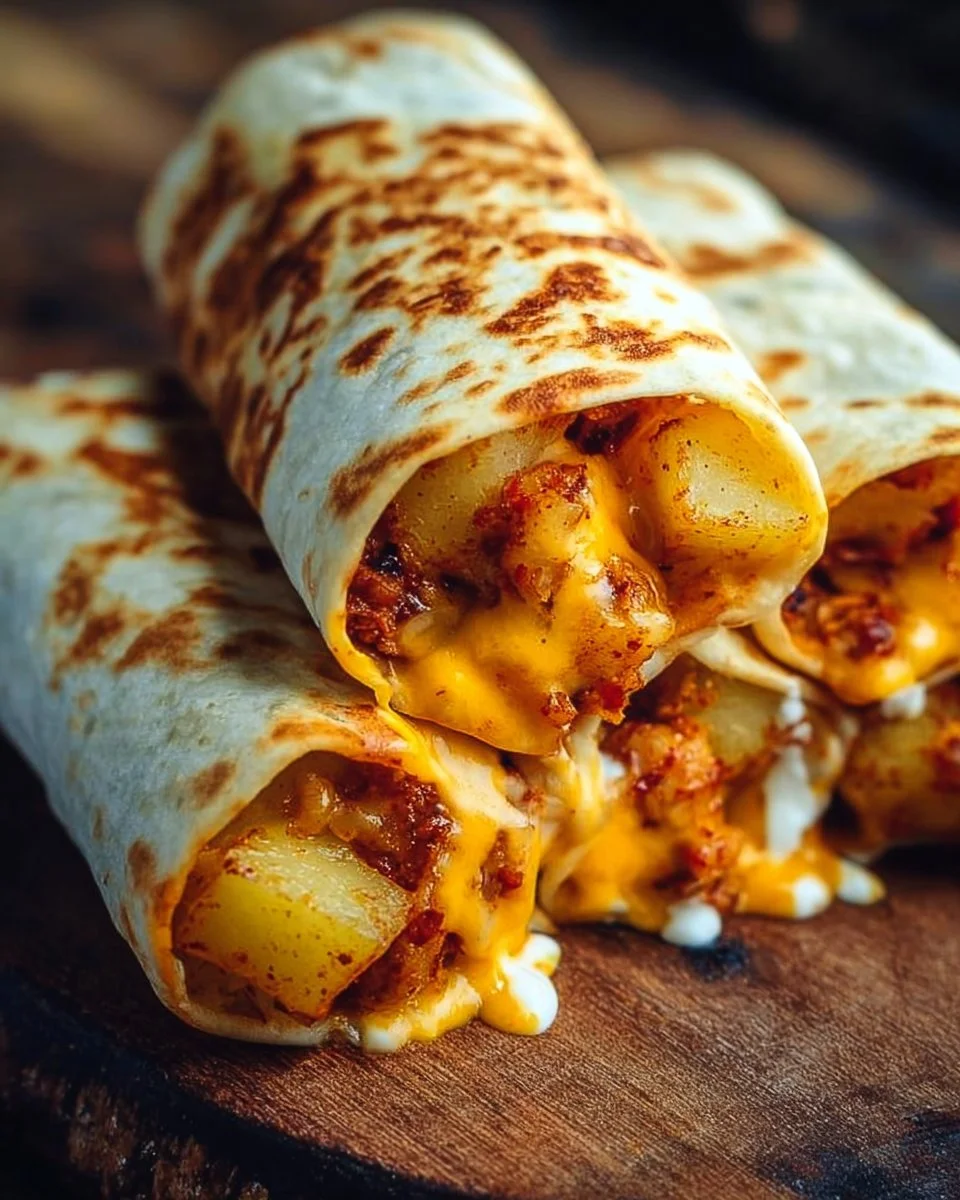
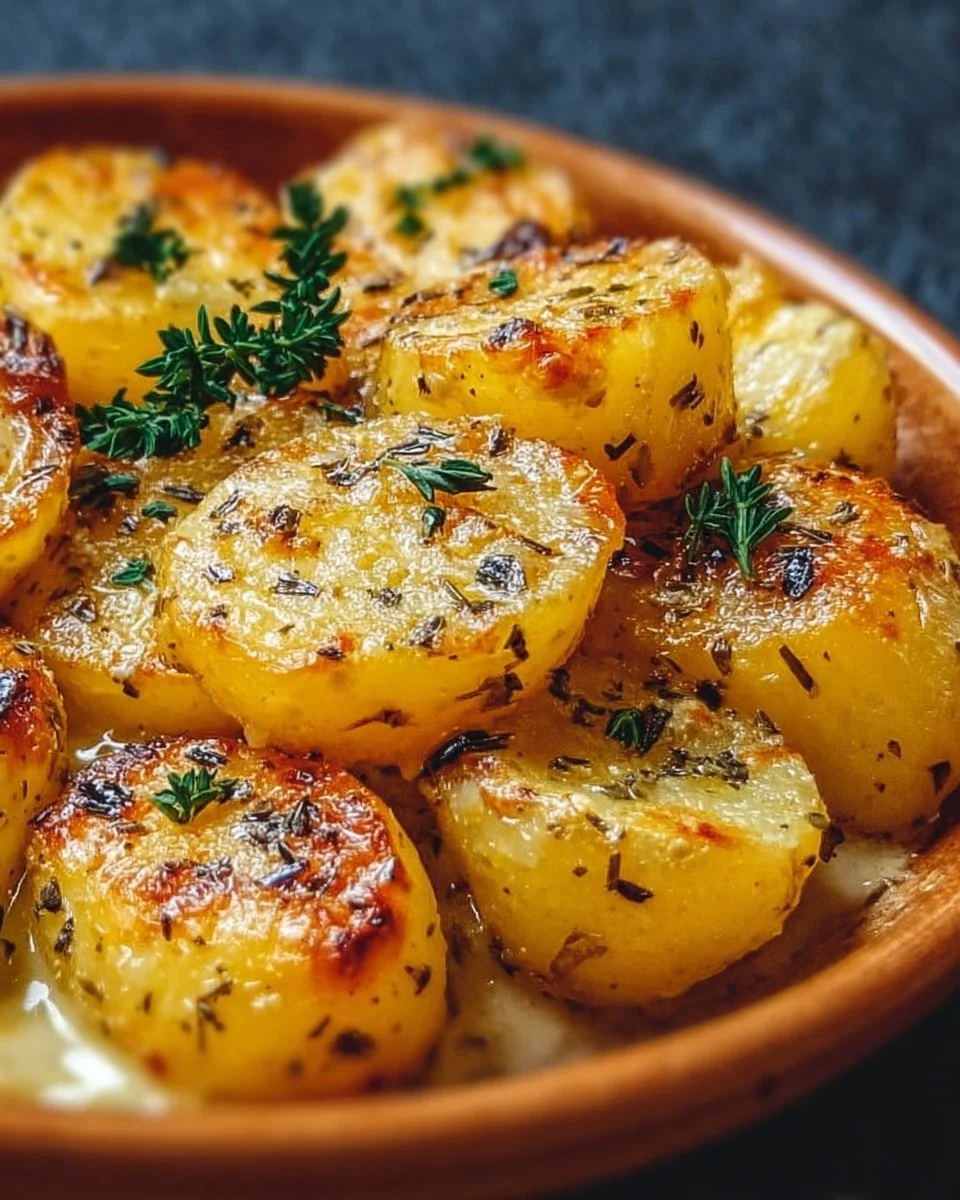
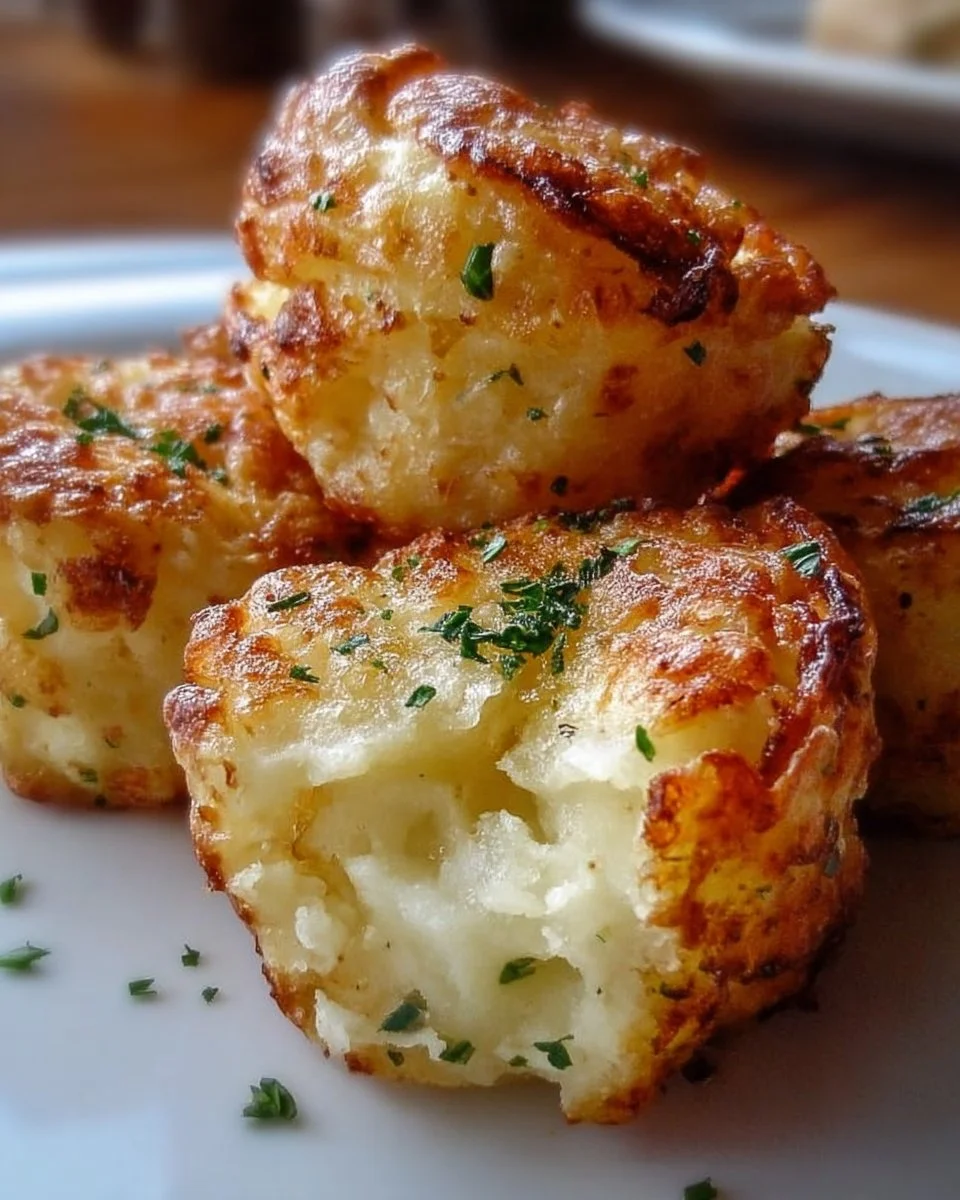
1 thought on “Vanilla Protein Powder: The Ultimate Guide”